简介
在使用内置锁synchronized时,通过调用java.lang.Objec中定义的监视器方法,主要有wait()、wait(long timeout)、notify()和notifyAll()方法,可以实现等待/通知模式。Codition接口中也定义了类似的监视器方法,与显示锁Lock配合使用也可以实现等待/通知模式。
当线程需要利用Condition对象进行等待时,需要提前获取到Condition对象关联的显示锁Lock对象,使用案例如下:
Lock lock = new ReentrantLock();
Condition condition = lock.newCondition();
//等待
public void coditionWait() throws InterruptedException {
lock.lock();
try {
condition.await();
}finally {
lock.unlock();
}
}
//通知
public void coditionSignal() throws InterruptedException {
lock.lock();
try {
condition.signal();
}finally {
lock.unlock();
}
}
Condition接口由同步器AbstractQueuedSynchronizer内部类ConditionObject提供实现,而显示锁Lock对象实现时内部类Sync会继承AQS,从而把Condition对象与Lock对象关联起来。
等待队列
在上一篇博客中介绍到为了处理多个线程竞争同一把锁,同步器AQS中维护了一个先入先出的双向同步队列,让竞争失败的线程进入同步队列等待。同样,AQS在实现Condition接口也维护了一个先入先出的单向等待队列,当一个与Lock对象关联的Condition对象调用await方法,获得锁的线程就要释放锁,并推出同步队列head头节点,进入condition等待队列。condition队列规定了头节点firstWaiter和尾节点lastWaiter。
public class ConditionObject implements Condition, java.io.Serializable {
private static final long serialVersionUID = 1173984872572414699L;
/** First node of condition queue. */
private transient Node firstWaiter;
/** Last node of condition queue. */
private transient Node lastWaiter;
}

AQS中构建等待队列复用了内部类Node结点类
static final class Node {
//等待状态
volatile int waitStatus;
//前驱结点
volatile Node prev;
//后继节点
volatile Node next;
//等待获取锁的线程
volatile Thread thread;
//condition队列的后继节点
Node nextWaiter;
}
nextWaiter
从上图可以发现,Condition等待队列是一个先入先出的单向链表,从链表尾部加入元素,头部移出链表。使用nextWaiter指向下一个等待节点,构成链表的基本元素是节点Node,复用了AQS中的Node类,nextWaiter并不单单在Condition链表指向下一个等待节点。这是Node类定义nextWaiter的注释:
Link to next node waiting on condition, or the special value SHARED. Because condition queues are accessed only when holding in exclusive mode, we just need a simple linked queue to hold nodes while they are waiting on conditions. They are then transferred to the queue to re-acquire. And because conditions can only be exclusive,we save a field by using special value to indicate sharedmode.
大意是只有独占锁才会关联Condition队列,通过nextWaiter变量在构成同步队列节点标识同步锁是独占锁还是共享锁,从以下方法可以看出AQS使用nextWaiter来表示锁:
/** Marker to indicate a node is waiting in shared mode */
static final Node SHARED = new Node();
/** Marker to indicate a node is waiting in exclusive mode */
static final Node EXCLUSIVE = null;
//判断是否是共享锁
final boolean isShared() {
return nextWaiter == SHARED;
}
//构建同步队列节点,nextWaiter标识同步锁是独占锁还是共享锁
Node(Thread thread, Node mode) { // Used by addWaiter
this.nextWaiter = mode;
this.thread = thread;
}
//构建等待队列节点,nextWaiter指向单向链表下一个节点
Node(Thread thread, int waitStatus) { // Used by Condition
this.waitStatus = waitStatus;
this.thread = thread;
}
从以上分析可以看出:AQS复用了Node类来构建同步队列和等待队列,Node用来构建同步队列节点,nextWaiter标识同步锁是独占锁还是共享锁;Node用来构建等待队列节点,nextWaiter指向单向链表下一个节点。刚开始看这一部分时,对我造成了很大的困扰,所以特地写出来。
源码分析
await()
await实现等待考虑到了中断,若当前线程等待期间发生中断,抛出InterruptedException异常。线程在等待期间会被阻塞,直到发生中断或者Condition对象调用signal方法。基本流程:首先将node加入condition队列,然后释放锁,挂起当前线程等待唤醒,唤醒后线程重新进入同步队列并调用acquireQueued获取锁。流程图如下:

public final void await() throws InterruptedException {
if (Thread.interrupted())
throw new InterruptedException();
//将当前线程加入Condition等待队列
Node node = addConditionWaiter();
int savedState = fullyRelease(node);
int interruptMode = 0;
//判断当前线程是否在同步队列中
while (!isOnSyncQueue(node)) {
//阻塞当前线程
LockSupport.park(this);
//在阻塞的过程中发生中断
if ((interruptMode = checkInterruptWhileWaiting(node)) != 0)
break;
}
//被其他线程唤醒,退出Condition等待队列加入同步队列
//获取锁
if (acquireQueued(node, savedState) && interruptMode != THROW_IE)
interruptMode = REINTERRUPT;
if (node.nextWaiter != null) // clean up if cancelled
unlinkCancelledWaiters();
if (interruptMode != 0)
reportInterruptAfterWait(interruptMode);
}
- addConditionWaiter()
以当前线程构成节点Node加入等待队列,因为加入Condition等待队列在释放锁之前,所以不需要考虑并发的情况,就不需要像加入同步队列采用循环加CAS的机制。
private Node addConditionWaiter() {
Node t = lastWaiter;
// If lastWaiter is cancelled, clean out.
//如果尾节点lastWaiter等待状态是CANCELLED,将队列所有CANCELLED节点清除
if (t != null && t.waitStatus != Node.CONDITION) {
unlinkCancelledWaiters();
t = lastWaiter;
}
//以当前线程构成节点
Node node = new Node(Thread.currentThread(), Node.CONDITION);
//尾节点为空,等待队列为空,进行初始化,当前节点是等待队列的头节点
if (t == null)
firstWaiter = node;
//否则添加到等待队列的尾部,当前节点是等待队列新的lastWaiter
else
t.nextWaiter = node;
lastWaiter = node;
return node;
}
//unlinkCancelledWaiters方法遍历CONDITION队列,删除状态为CANCELLED的节点。
private void unlinkCancelledWaiters() {
//首节点
Node t = firstWaiter;
//保存遍历节点前驱节点的引用
Node trail = null;
//单向链表从前往后遍历
while (t != null) {
//下一个节点
Node next = t.nextWaiter;
//节点t的waitStatus为CANCELLED
if (t.waitStatus != Node.CONDITION) {
t.nextWaiter = null;
if (trail == null)
firstWaiter = next;
else
trail.nextWaiter = next;
if (next == null)
lastWaiter = trail;
}
else
trail = t;
t = next;
}
}
- fullyRelease(Node node)
完全释放锁,释放成功则返回,失败则将当前节点(在Condition队列)的状态设置成CANCELLED表示当前节点失效
final int fullyRelease(Node node) {
boolean failed = true;
try {
//获取同步状态
int savedState = getState();
//如果是重入锁,要多次释放
if (release(savedState)) {
failed = false;
return savedState;
} else {
throw new IllegalMonitorStateException();
}
} finally {
if (failed)
node.waitStatus = Node.CANCELLED;
}
}
- isOnSyncQueue(Node node)
判断node节点是否被signal方法从condition队列转移到同步队列
final boolean isOnSyncQueue(Node node) {
//转移到同步队列,CONDITION状态会被清除
//同步队列prev表示前驱结点,不为null
if (node.waitStatus == Node.CONDITION || node.prev == null)
return false;
//同步队列next表示后继节点,不为null
if (node.next != null) // If has successor, it must be on queue
return true;
/*
* node.prev can be non-null, but not yet on queue because
* the CAS to place it on queue can fail. So we have to
* traverse from tail to make sure it actually made it. It
* will always be near the tail in calls to this method, and
* unless the CAS failed (which is unlikely), it will be
* there, so we hardly ever traverse much.
*/
//遍历同步队列,一个一个找
return findNodeFromTail(node);
}
- checkInterruptWhileWaiting(Node node)
检查当前线程在等待状态时中断状态,返回REINTERRUPT标志位,退出等待状态时调用selfInterrupt方法产生中断;返回THROW_IE标志位,线程退出等待状态时会抛出InterruptedException异常。
//表示从等待状态退出时会重新产生一个中断,但不会抛出异常
private static final int REINTERRUPT = 1;
//从等待状态退出时抛出InterruptedException异常
private static final int THROW_IE = -1;
/**
* Checks for interrupt, returning THROW_IE if interrupted
* before signalled, REINTERRUPT if after signalled, or
* 0 if not interrupted.
*/
private int checkInterruptWhileWaiting(Node node) {
return Thread.interrupted() ?
(transferAfterCancelledWait(node) ? THROW_IE : REINTERRUPT) :
0;
}
- reportInterruptAfterWait(int interruptMode)
根据interruptMode对应的标志位响应中断
private void reportInterruptAfterWait(int interruptMode)
throws InterruptedException {
//产生异常
if (interruptMode == THROW_IE)
throw new InterruptedException();
//产生中断
else if (interruptMode == REINTERRUPT)
selfInterrupt();
}
signal()
检查当前线程是否占据独占锁,唤醒等待在当前Condition对象等待最久的线程(等待队列的头节点)
public final void signal() {
//检查当前线程是否占据独占锁,如果不是没有权限唤醒等待线程,抛出异常
if (!isHeldExclusively())
throw new IllegalMonitorStateException();
Node first = firstWaiter;
if (first != null)
doSignal(first);
}
private void doSignal(Node first) {
do {
if ( (firstWaiter = first.nextWaiter) == null)
lastWaiter = null;
first.nextWaiter = null;
} while (!transferForSignal(first) &&
(first = firstWaiter) != null);
}
- transferForSignal(Node node)
将当前线程从Condition等待队列转移到同步队列中,看到这里应该明白为什么await方法以节点是否在同步队列(isOnSyncQueue(node))做为循环条件了。
final boolean transferForSignal(Node node) {
/*
* If cannot change waitStatus, the node has been cancelled.
*/
//如果CAS设置失败,说明节点在signal之前被取消了,返回false
if (!compareAndSetWaitStatus(node, Node.CONDITION, 0))
return false;
//CAS设置成功,入队
//插入节点的前驱节点
Node p = enq(node);
//前驱节点的等待状态
int ws = p.waitStatus;
//如果p等待状态为CANECLLED或对p进行CAS设置失败,则唤醒线程,让node中线程进入acquireQueued方法。否则
//由于前驱节点等待状态为signal,由同步器唤醒线程
if (ws > 0 || !compareAndSetWaitStatus(p, ws, Node.SIGNAL))
LockSupport.unpark(node.thread);
return true;
}
signalAll()
将等待队列所有节点依次转移到同步队列末尾。
public final void signalAll() {
if (!isHeldExclusively())
throw new IllegalMonitorStateException();
Node first = firstWaiter;
if (first != null)
doSignalAll(first);
}
private void doSignalAll(Node first) {
lastWaiter = firstWaiter = null;
do {
//first节点从condition队列移出
Node next = first.nextWaiter;
first.nextWaiter = null;
//first节点加入同步队列
transferForSignal(first);
//更新first节点指向
first = next;
} while (first != null);
}
总结
以上是对AQS中内部类ConditionObject对Condition接口实现的简单分析。